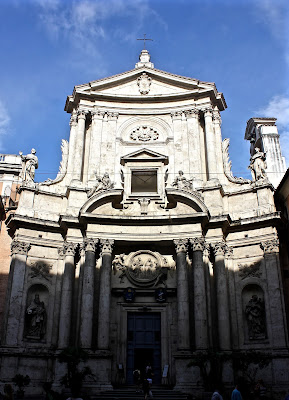A Roman Tragedy: the Casino dell'Aurora.
One of Rome's many beautiful and somewhat hidden treasures is what is known as the Casino di Villa Boncompagni Ludovisi or Casino or Villa dell'Aurora, after its Guercino masterpiece. This beautiful country house was originally built in 1570 by Francesco del Nero, known as Cecchino, an apostolic secretary and a nephew of Niccolò Machiavelli. Later in the century, it was purchased by Cardinal Francesco del Monte, a patron of the arts and sciences, among his favorite artists was Caravaggio himself. In 1621-1623, the villa was sold to Ludovico Ludovisi, as part of his acquisition campaign - his uncle Alessandro had become Pope Gregory XV, the man who gave us our current "Gregorian" calendar.
The cardinal expanded the property which ended up forming a great park known as the Villa Ludovisi that survived until the late 19th century, when the the Rione Boncompagni-Ludovisi was urbanized. The Casino was "just" the gardens' hunting lodge, the family palazzo, Palazzo Piombino (after the family title of Principe di Piombino), was originally down the Corso in Piazza Colonna and later by the Via Veneto. The only building that survives is the Palazzo Margherita, the former family palazzo which then passed on to the Italian Royal Family and is now the American Embassy.
Through the centuries many stayed at the villa, American poet Henry James wrote of its gardens: "certainly there is nothing better in Rome, and perhaps nothing so beautiful, inside there is everything: dark avenues shaped for centuries with scissors, valleys, clearings, groves". The Casino dell'Aurora is home to splendid artworks: from the fine Greek and Roman statues, once part of a much larger collection and now spread throughout various museums, including the Palazzo Massimo alle Terme, a rather rude sculpture of Pan by Michelangelo in the garden, to the intriguing Pomarancio Mannerist craze as one enters the building.
The most renowned works in the house include Caravaggio's only wall painting representing Jupiter, Neptune, and Pluto (c.1597) and Guercino's Aurora (c.1621), Aurora is the goddess of dawn in Roman mythology, she renews herself every morning and announces the coming of the sun by flying across the sky on her chariot. These are some of the most defining art pieces of the Baroque era in Rome.
Visiting this beautiful Roman villa was always a pleasure, from the Mannerist frescoes to the unique masterpieces by Caravaggio and Guercino. Since 2021, due to a family dispute, following the death of Prince Niccolò Boncompagni Ludovisi, the house has been put on sale by the Italian government (which cannot wait on taking hold of another historic property it cannot maintain). So far there have been several bids and the price which was originally half a billion euros has been more than halved. The local court has ordered the princess to be evicted after coming up with unfounded accusations on the fabric of the building and her management of the same.
What a shame that the Italian government, and some judges who came from nowhere, are so full of envy and greed. The current resident, Princess Rita Boncompagni Ludovisi (who is also a good friend of Anglican Rome), has been nothing short of a cross between a Renaissance and a Gilded Age philanthropist; her love and care for both the poor and orphan in Rome, as well as the care for this amazing fabric and its archival patrimony has been incredible and very generous indeed. This included the recent restoration of the villa and the setting up of a family archive that includes extremely valuable documents.
One of the charms of Rome is that its palazzos are still lived in by the families that made this Eternal City. After the Altieri, Barberini, and more recently, the Sacchetti... another family loses its Roman seat. My fear is that this beautiful villa, home to much, unique art pieces, will become an empty, sterile space like the Barberini, the Corsini, the Spada galleries and many others... (not to take anything away from the wonderful people that run these museums with very little resources) making it a sad shadow of what it once was. No more patrons of the arts and culture will host artists or indeed, the orphan. I am not looking forward to the day when hordes of teenagers will stick their chewing gums to a badly written sign below the Caravaggio ceiling. A day that will see the walls of this villa crumble because most funds are almost exclusively directed towards archeological sites in this city. Given that day will ever come. God save our city from the heathen.





